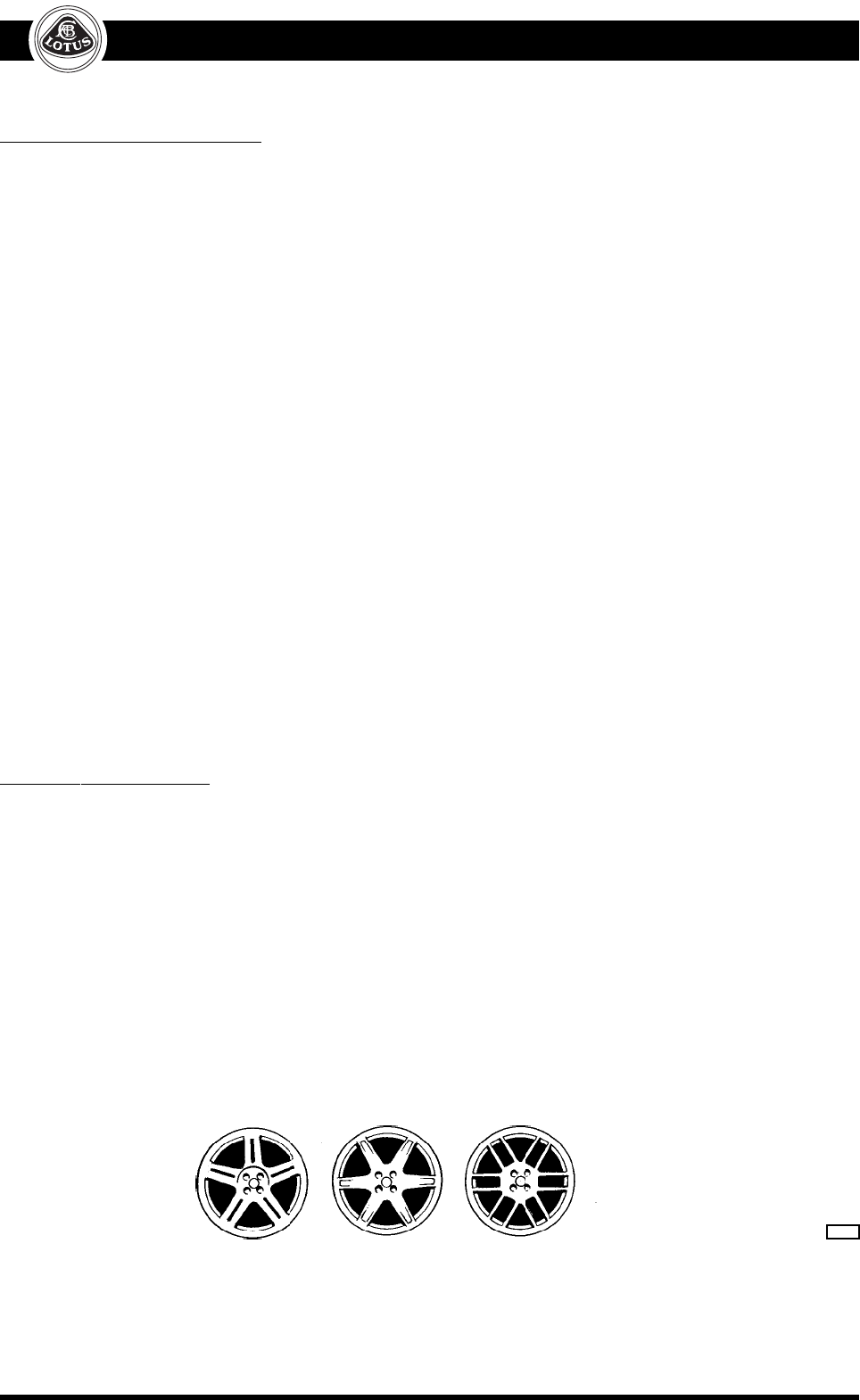
Lotus Service Notes Section GF
Page 2
GF.1 - GENERAL DESCRIPTION
The single piece, light alloy roadwheels, in various styles, are fitted with Pirelli P Zero tyres, engineered
to provide the optimum balance of ride and handling characteristics. Pirelli P Zero are the recommended tyres
for use on the vehicle under normal road conditions. In order to fully exploit the dynamic qualities and packag-
ing opportunities, the wheel and tyre sizes are different front and rear, so that interchanging of wheels and tyres
between axles is not permissible. Note that the tyre tread pattern is asymmetric with the tyre sidewalls marked
Inner and Outer; check that replacement tyres are correctly fitted. Part of the tread pattern is also directional
in appearance, but the direction of rotation has no bearing on the tyre performance.
The tyres should be inspected frequently by the vehicle user, and also at every service, for signs of cuts,
abrasions or other damage, and for any uneven tread wear patterns. Uneven treadwear may indicate that the
suspension geometry or dampers require attention. Care should be taken when parking to avoid tyre contact with
high or sharp edged kerbs, as mistreatment of this nature can cause internal damage to the tyre structure which
may not be readily apparent. The alloy wheel rims may also be distorted or damaged by careless parking, and
result in wheel imbalance or loss of tyre pressure. Safety considerations should always be paramount when
assessing tyre condition and serviceability, and the tyres replaced if any doubt exists, or if the legal tread depth
limits are approached.
The cold tyre pressures should be checked every week, or every 1,000 miles (1,700 km), whichever is the
sooner, and corrections made as necessary. Under-inflation will cause excessive wear, rapid deterioration of the
tyre sidewalls and heavy steering, whereas overinflation results in a hard ride and increased susceptibility to tyre
damage. Both conditions will cause a degradation in the vehicle handling qualities. It is important that the tyre
pressures are adjusted only when the tyres are cold (driven less than one mile), as the pressures may increase by
0.3 - 0.5 bar (4 - 8 lb/in²) when the tyres are warmed to normal running temperature. The tyre valve dust cap
should always be replaced in order to prevent the ingress of dirt and moisture into the valve, which could cause
leakage.
When balancing the wheel and tyre assemblies, the wheels should be located by the centre spigot - NOT by
the wheel bolt holes. In order to maintain the correct handling feel and minimum steering wheel shake, it is very
important that the radial and lateral run out of the tyres are to the high standard required by Lotus Cars. If any
difficulty is experienced with replacement tyres, refer to the tyre manufacturer.
Wheel & Tyre Specification
Wheels
Type - std. prior April '99 * AWI light alloy; 5 split-spoke style * Approx. VIN X 6429
- std. from April '99 * Rimstock light alloy; 12 spoke style
- 111S & std. option O.Z. light alloy; 6 spoke style
Size - front 5.5J x 15CH/H2 ET14
- rear - std 7J x 16H2 ET16
- 111S & std. option 7.5J x 16H2 ET10
PCD 95.25 mm
Inset - front + 14 mm
- rear - std + 16 mm
- 111S & std. option + 10 mm
Wheel nut torque 80 - 85 Nm
Radial run-out at bead seat 0.3 mm max.
Lateral run-out at rim flange 0.3 mm max.
3401a
AWI O.Z. Rimstock







